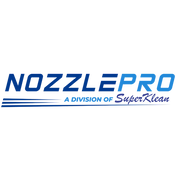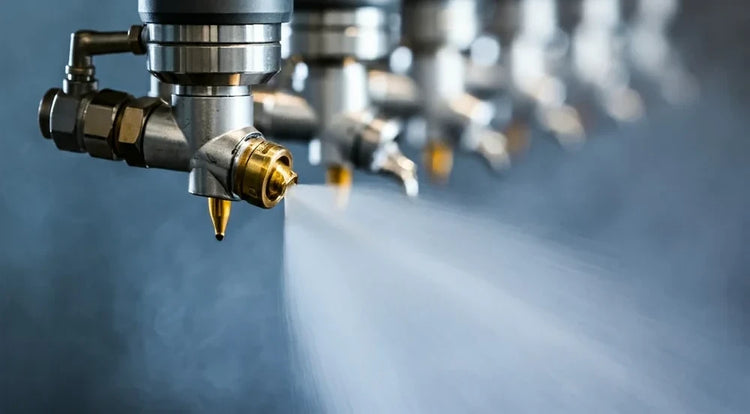The Definitive Guide to Mining Spray Nozzle Fundamentals
Master the engineering principles that transform dust control from guesswork into precision science. From droplet physics to total cost of ownership—everything mining professionals need to know.
📄 19 pages of technical excellence | 🔬 Science-backed engineering | 📊 Real-world mining applications
Why Every Mining Professional Needs This Guide
Safety & Compliance
Understand how proper nozzle selection prevents respiratory diseases and meets MSHA/EPA requirements. The difference between visible dust control and respirable dust suppression can save lives.
Profitability & ROI
Learn why total cost of ownership beats upfront pricing. Discover how the right system pays for itself in weeks, not years—through water savings, reduced maintenance, and avoided fines.
Engineering Excellence
Master the physics of atomization, droplet sizing, and agglomeration. Make data-driven decisions on spray patterns, materials, and system design instead of relying on outdated industry assumptions.
Solve Your Pain Points
Clogging, wear, and inefficiency aren't equipment failures—they're system design failures. Learn how to engineer solutions that eliminate downtime and improve uptime permanently.
Competitive Advantage
While your competitors operate with incomplete knowledge, you'll have the technical authority to specify systems that actually work. Reduce material loss from fugitive dust by up to 60%.
Application-Specific Solutions
Real engineering guides for crushers, conveyors, screens, and transfer points. No generic recommendations—only actionable systems designed for your exact mining environment.
What's Inside This 19-Page Technical Guide
- Foundational Spray Principles — Atomization, spray patterns, and fluid dynamics that control droplet size
- Droplet Physics for Mining — Why PM10 and PM2.5 require specific droplet sizes, and how agglomeration actually works
- Dry Fog vs. Misting Technology — Deep dive on air atomizing vs. high-pressure hydraulic systems, with TCO analysis
- Systematic Design Approach — Prevention vs. suppression, dual-manifold systems, and the "Enclose → Prevent → Suppress" methodology
- Application Engineering — Step-by-step guides for crushers, conveyors, screens, and transfer point design
- Material Science & Wear Analysis — Performance comparison of stainless steel, ceramics, and tungsten carbide in abrasive environments
- Clogging Solutions — Why filtration solves the problem at its source, plus clog-resistant nozzle design options
- Financial Analysis — Total Cost of Ownership (TCO) framework that shows real ROI through risk mitigation
- Real-World Case Studies — Proven examples of 2-week payback, 75% fine reductions, and $350K+ risk avoidance
- FAQ & Troubleshooting — Technical Q&A addressing the most common mining industry challenges
📊 19 Pages of Technical Content
Includes 2 Performance Matrices: Nozzle Material Performance Matrix for Mining Environments | TCO Comparison of Advanced Dust Suppression Systems
Essential Sections for Mining Professionals
Atomization & Spray Patterns
Understand pressure-flow relationships and why hollow cone nozzles produce the finest droplets of any hydraulic design.
Droplet-to-Dust Physics
The science of agglomeration: why larger droplets can actually push fine dust away, and the optimal 5-35 micrometer droplet range.
Dust Prevention vs. Suppression
Why the best systems use dual-manifold designs—preventing dust at the source while suppressing airborne particles separately.
Conveyor Transfer Solutions
Responsible for 30-60% of fugitive dust. Learn the three-step "Enclose-Prevent-Suppress" approach that eliminates it.
Material Durability Analysis
Why 316L stainless steel wears out in 1-2 months, while tungsten carbide lasts 12+ months in abrasive slurries.
TCO & ROI Framework
Stop focusing on component cost. Discover how risk mitigation delivers 2-week payback through compliance and safety.
Before vs. After: The Knowledge Gap
❌ Without This Guide
- Treating nozzles as commodities based on price
- Assuming "more water = better dust control"
- Not understanding droplet size requirements
- Ignoring total cost of ownership analysis
- Choosing systems based on initial CapEx
- Experiencing frequent clogging and downtime
- Missing compliance and safety opportunities
✓ With This Guide
- Specifying precision-engineered solutions backed by physics
- Matching droplet size to dust particle size (PM10, PM2.5)
- Understanding agglomeration and energy efficiency
- Calculating real ROI through risk mitigation
- Choosing systems that minimize lifetime operating costs
- Implementing filtration solutions that solve clogging permanently
- Proactively meeting MSHA and EPA requirements

